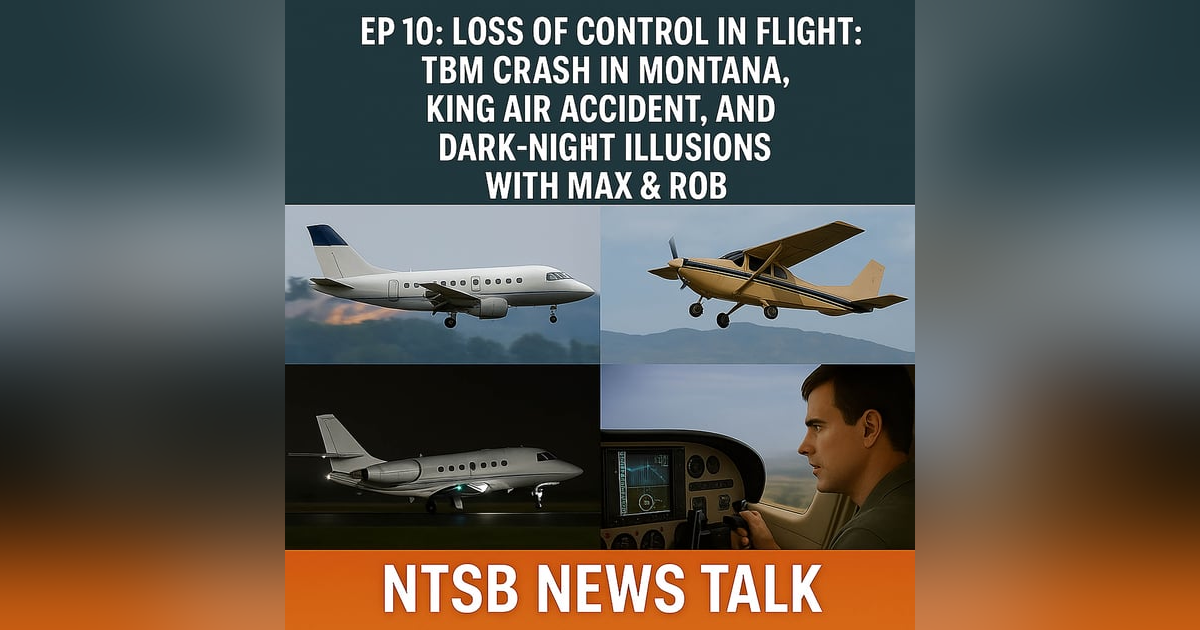NTSB Accident Reports: TBM & King Air Loss of Control

In Episode 10 of NTSB News Talk, aviation safety experts Max Trescott and Rob Mark examine recent accident reports that reinforce why loss of control in flight continues to be the number one cause of fatalities in general aviation. Drawing from official NTSB accident reports and preliminary findings, they analyze crashes involving a TBM turboprop in Montana, a Beechcraft King Air in Arizona, and other cases where night flying illusions and equipment failures played a decisive role.
TBM Crash in Kalispell, Montana
Rob begins with an August accident in Kalispell, Montana, where a TBM turboprop attempted to land at the city airport. Witnesses said the aircraft touched down near the approach end of the runway before veering into parked planes, sparking a fire. Incredibly, all four occupants survived with only minor injuries. Though details are still sparse, the incident highlights how quickly loss of control can occur even in a high-performance single-engine turboprop.
Max and Rob stress that while the TBM is an advanced and capable aircraft, any landing can go wrong if the pilot mismanages energy or fails to stabilize the approach. This accident serves as a reminder that precision, discipline, and preparation remain critical during the landing phase, when the margin for error is smallest.
King Air 300 Crash in Chinle, Arizona
The hosts then turn to a tragic August 5th accident involving a Beechcraft King Air 300 on the Navajo Nation in eastern Arizona. The aircraft was inbound on a medical transport flight, but before picking up its patient it crashed near the single runway at Chinle Municipal Airport. All four aboard—two pilots and two healthcare providers—were killed.
Conditions that day created a perfect storm: a density altitude of over 8,400 feet combined with gusty crosswinds approaching 28 knots, nearly 90 degrees to the runway. The demonstrated crosswind limit for the King Air 300 is 20 knots, but as Rob explains, that number is not a hard limitation—it simply reflects the strongest crosswind tested during certification. What really matters is pilot proficiency.
The Chinle crash underscores the dangers of trying to land in challenging conditions when performance margins are already compromised by high elevation and high temperature. For many pilots, especially those not flying crosswind landings regularly, the combination can quickly exceed skill level and lead to loss of control.
Cessna Conquest II Crash in Ohio
Rob next covers a preliminary report on a Cessna Conquest II that departed Youngstown, Ohio, en route to Bozeman, Montana. Security video showed the aircraft lifting off after a normal ground roll, but instead of climbing, it leveled off at just 100 feet and maintained that altitude until impacting trees. Both engines were reportedly running, making the lack of climb especially puzzling.
Witnesses described unusual engine sounds, but Max and Rob note that eyewitness accounts are often unreliable. The bigger mystery is why the pilot failed to climb, despite having ample power available. Possible scenarios include distraction, incapacitation, or improper handling of the aircraft. As Max points out, 80 percent of accidents are linked to human error, and this crash may ultimately fall into that category.
Night Illusions and the Needles, California Accident
Max then shares insights into a Piper PA-28 crash in Needles, California, where two low-time pilots were building hours for airline transport certification. After a go-around at night, the aircraft crashed almost immediately. The conditions—dark desert terrain with no horizon—were ideal for somatogravic illusion, a common cause of accidents at night.
Somatogravic illusion occurs when acceleration tricks the body into feeling like it is pitching up, leading pilots to push forward on the controls when they should be climbing. With little visual reference and limited experience, the pilots in this case likely succumbed to the illusion. Max emphasizes that pilots flying in dark-night conditions must always cross-check instruments, especially the vertical speed indicator, to confirm a positive rate of climb.
Final Reports: Mooney in Maryland and King Air in Hawaii
The episode also examines two final NTSB reports. The first involved a Mooney that struck power lines near Gaithersburg, Maryland, while flying an approach in dark night IMC. Photos of the aircraft wedged into a transmission tower made national headlines. The investigation revealed the pilot was unfamiliar with his IFR-certified GPS and often relied on a handheld unit instead. Poor avionics knowledge combined with descent below minimums led to the crash.
The second report focused on a Hawaii medical transport King Air C90 that crashed into the ocean at night after its attitude indicator failed. Cockpit video captured the pilot listening to music and chatting with crew before the failure, and later struggling to control the aircraft without reliable instruments. The NTSB cited inadequate training and a history of poor checkride performance as contributing factors. The accident reinforced the critical need for proficiency in hand-flying and backup instrument skills.
Key Lessons for Pilots
Throughout the discussion, Max and Rob emphasize several recurring themes:
- Loss of control remains aviation’s deadliest risk. Even experienced pilots can miss upset cues or fall victim to illusions.
- Avionics knowledge is essential. Pilots must know their GPS and autopilot systems thoroughly to avoid confusion in high-stress situations.
- Simulator training pays off. Practicing hand-flying, instrument failures, and upset recovery in a safe environment builds resilience.
- Dark-night conditions are uniquely hazardous. Without lights or a horizon, illusions can overwhelm even competent pilots.
- Altitude and proficiency are survival tools. Whether flying a TBM, King Air, or a light single, the best defense is disciplined flying and constant preparation.
Episode 10 of NTSB News Talk demonstrates that while technology and aircraft performance continue to advance, pilot proficiency and decision-making remain the decisive factors in aviation safety. From Montana to Arizona, Ohio to Hawaii, the NTSB’s accident reports show that staying sharp, staying current, and understanding the human factors behind loss of control can save lives.
Please check out these other podcasts in the Aviation News Talk Network: